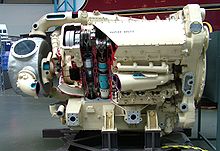D. Napier & Son
Napier made a wide variety of products, including a centrifuge for sugar manufacturing, lathes and drills, ammunition-making equipment for the Royal Arsenal, Woolwich, and railway cranes.[2] Montague was a hobby racing cyclist, and at the Bath Road Club, he met "ebullient Australian" S. F. Edge (then a manager at Dunlop Rubber and colleague of H. J. Lawson in London, and amateur racer of motor tricycles.)[3] Dissatisfied, Napier offered to fit an engine of his own design, an 8 hp vertical twin, with electric ignition, superior to the Panhard's hot tube type.[5] Recognizing the value of publicity gained from racing, which no other British marque did,[6] in spring, Edge entered an 8 hp (6.0 kW) Napier in the Thousand Miles (1,600 km) Trial of the Automobile Club on behalf of Mary Eliza Kennard; driven by Edge, with Kennard along, on a circuit from Newbury to Edinburgh and back, it won its class, being one of only thirty-five finishers (of sixty-four starters[7]) and one of just twelve to average the requisite 12 mph (19 km/h) in England and 10 mph (16 km/h) in Scotland.[8] By June 1900, eight "16 hp"s had been ordered, and Edge entered one in the 837 mi (1,347 km) Paris-Toulouse-Paris race, with Charles S. Rolls (co-founder of Rolls-Royce) as riding mechanic.[10] Edge entered one in the 1901 Gordon Bennett Cup, only able to test it en route (it was completed 25 May, only four days before the event), Montague serving as his riding mechanic; it overpowered its Dunlops, and fitting new (French) tyres led to disqualification, since they were not of the same nation of origin.[10] Within five years, there were 62 makers of six-cylinder cars in Britain alone, including the Ford Motor Company's 1906 Model K.[14] Napier's 1902 win brought the Gordon Bennett hosting duties to the United Kingdom, and the 1903 event was held south of Dublin, with three shaft-driven Napiers defending the British honour, all in the (later famous) racing green: two 470 cubic inch (7708 cc) 45 hp (34 kW) fours for Charles Jarrott and J. W. Stocks, with McDonald, the Genoa plant manager, his riding mechanic, and an 80-horsepower (838 cubic inch, 13,726 cc), the Type K5, for Edge.[15] It was a bad year for Napier's racing programme; a 35 hp in the hands of Colonel Mark Mayhew in the Paris–Madrid rally lost its steering and hit a tree.[16] In January 1905, the L48, again with McDonald in the seat, took the mile (1.6 km) record at Ormonde Beach at 104.65 mph (168.42 km/h); although this was shortly broken by Bowden's Mercedes, the run was disallowed.The versatile McDonald ran the L48 in the 1905 Gordon Bennett qualifying event at the Isle of Man, taken over for the race by works driver Clifford Earp, who placed ninth.[17] The L48, nicknamed Samson, became famous there in the venue's first two years; in 1908, Napier's Frank Newton covered one-half mile (800 m) at 119.34 mph (192.06 km/h) in a stroked (178 mm, 7-inch) L48.[15] The company's last race win was with a four-cylinder at the 1908 Tourist Trophy, using an alias, Hutton, to preserve the reputation of the sixes, in the hands of Willy Watson.In 1903 a S. F. Edge's Napier launch won the inaugural British International Harmsworth Trophy for speedboats at Cork Harbour in Ireland, driven by Dorothy Levitt.She was then commanded to the royal yacht by King Edward VII where he congratulated her on her pluck and skill, and they discussed the performance of the boat and its potential for British government despatch work.Early in the war, Napier was contracted to build engines from other companies' designs: initially the model RAF 3, a V-12 by Royal Aircraft Factory, and then the V-8 Sunbeam Arab.[citation needed] As Lion sales faded, an attempt was also made to buy the bankrupt Bentley company in 1931 but Napier was outbid at the last minute by Rolls-Royce.During the war (1944) Napier was asked by the Royal Navy to supply a diesel engine for use in its patrol boats, but the Culverin's 720 hp (540 kW) was not nearly enough for its needs.Napier then designed under the leadership of Ernest Edward Chatterton, Chief Engineer, the Deltic, essentially three Culverins arranged in a large triangle.However, even better fuel economy could be had by flying a normal jet engine at much higher altitudes, while existing designs filled the "low end" of the market fairly well.











Edwardian eraaero enginesHawker TyphoonTempestEnglish ElectricWabtecDavid NapierblacksmithDuke of ArgyllshipbuildersScotlandSt Giles, Londonsteam-poweredprinting pressHansardHouses of ParliamentLambethcentrifugeammunitionRoyal ArsenalWoolwichMontagueracing cyclistS. F. EdgeDunlop RubberH. J. Lawsonmotor tricyclesPanhard1896 Paris–Marseille–Paristillersteering wheeloilingvertical twinelectric ignitionHarvey du CrosArthur MullinerNorthamptonchain driveCanadian RockiesCharles GliddenGlidden ToursVancouverracingAutomobile ClubMary Eliza KennardToulouseCharles S. Rollsriding mechanicsidevalvegearboxGordon Bennett Cup1902 Gordon BennettBritish racing greenHenry SegraveFrench Grand PrixCharles J. GliddenNew YorkArthur McDonaldFord Motor CompanyModel KDublinCharles JarrottJ. W. StocksCord 810PortmarnockOrmonde BeachMercedesIsle of ManClifford EarpDorothy LevittBrighton Speed TrialsBrooklandsFrank NewtonTourist TrophyWilly WatsonMalcolm CampbellNapier-Campbell Blue BirdCampbell-Napier-Railton Blue BirdGolden ArrowJohn CobbNapier-RailtonRailton Mobil SpecialHarmsworth TrophyCork Harbourroyal yachtKing Edward VIIGaston Menier Cupwater speed recordNapier LionWar OfficeRoyal Aircraft FactorySunbeam ArabW-blockRoyal Aircraft Factory R.E.7Royal Aircraft Factory R.E.8Sopwith SnipesA. J. RowledgeRolls-Roycecylinder headbearingcrankshaftmagnetoSU CarburettorCunardRolls-Royce Silver Ghostland speed recordX styleBlackburn CubarooRapierDaggerBentleyScammellNapier Sabresleeve valveH-blockFrank Halforddiesel aircraft enginesJunkers Jumo 204Culverin"Whaleback" Air Sea RescueNapier DelticRoyal Navypatrol boatsDelticlocomotiveBritish Rail